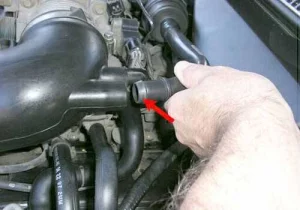If you own a car, you have likely heard about the TPS sensor, which helps determine the amount of fuel needed to run the engine.
If this part is functioning properly, you will get excellent car performance and lower fuel consumption. However, if it gets damaged, you may face driving problems and potentially you may need to pay for costly repairs.
We will discuss the TPS sensor and the signs of its damage to avoid the harm that could occur due to neglecting this important part in your car.
What is the TPS sensor and what is its function?

The TPS sensor, an abbreviation for Throttle Position Sensor, also known as the throttle sensor or choke sensor, works by monitoring the position of the gas pedal and transmitting this information to the engine control unit to ensure the car receives the appropriate amount of fuel corresponding to the driving process.
The TPS sensor consists of a movable tip placed at the end of the pedal shaft, which is installed at the end of the car's brake box. The tip moves with the movement of the gas pedal, and the current position is read through a set of resistors inside the sensor.
The throttle sensor is connected to the engine control unit, which reads the sensed values from the sensor and converts them into electronic signals that help control the output of the required fuel to the engine. When the TPS sensor relies on the lower peak to produce a low amount of fuel, the high output occurs when the sensor is at the upper peak.
The car needs an appropriate amount of fuel for effective and smooth movement on the road. When the TPS sensor is damaged, this may lead to insufficient fuel reaching the engine, causing it to stall and set off the car's warning alarms.
Therefore, it is essential to ensure the safety of the TPS sensor and perform the necessary preventive maintenance to avoid sensor damage problems and reduce the risk of car accidents and breakdowns.
What are the symptoms of TPS sensor damage?

Loss of power and torque
A loss of power or torque can be among the symptoms that indicate damage to the throttle sensor, as damage to the throttle sensor can lead to insufficient provision of fuel and air for the engine, resulting in a lack of torque and power in the car.
Therefore, you may feel a stutter or sluggishness while driving the car, and the car may become more difficult to accelerate and endure.
Weak acceleration
The throttle sensor is considered an important part in the engine's fuel and air system. Its main function is to determine the amount of fuel and air that the car needs to maintain a certain speed or to accelerate the car.
Also read: 5 Signs Indicating Damage to the Exhaust Sensor You didn't provide any text to be translated. Please provide the text you want me to translate.
When the throttle sensor is damaged, it can disrupt the amount of fuel and air that the engine receives, leading to a problem with the car's acceleration. When pressing the gas pedal, the appropriate amount of fuel and air is not transferred to the engine, resulting in a delay in response and slow acceleration.
Damage to the throttle sensor can cause a delay in transitioning from a stationary point to motion, meaning a delay in acceleration from a stationary or stopping position to motion. This means that the car will not start quickly enough, endangering the driver and passengers when driving in critical areas such as highways.
Increased fuel consumption
The TPS sensor controls the amount of fuel the engine receives. If the sensor is damaged, it can lead to inaccurate adjustments in the amount of fuel introduced to the engine.
Sensor damage leads to increased fuel consumption due to inaccurate control of the amount of fuel injected into the engine. This means the engine will need a larger amount of fuel to generate the same required power to maintain speed or accelerate the car.
Increased fuel consumption can lead to higher fuel costs for the owner, and can also negatively impact the overall performance of the car, including acceleration and top speed.
Increase in exhaust emissions
An increase in fuel consumption is not the only consequence of damage to the throttle sensor. In addition, sensor damage can lead to an increase in exhaust emissions.
The exhaust system relies on several factors to reduce emissions, one of these factors being the TPS sensor, which controls the amount of fuel that is injected into the engine.
If the throttle sensor is damaged, it may lead to the injection of an excess amount of fuel into the engine, which in turn burns the excess fuel, resulting in the emission of more harmful pollutants such as nitrogen oxides and carbon released from the exhaust.
Check Engine Light
The light is consideredCheck the illuminated engineOne of the signs of sensor damage in a car, especially the TPS sensor, is when the sensor sends signals to the engine control unit to allow the proper regulation of fuel and air flow into the engine.
When the TPS sensor breaks down, it cannot send the correct signals to the engine control unit, which leads to the improper regulation of fuel and air flow. This can cause the check engine light to illuminate.

Comments